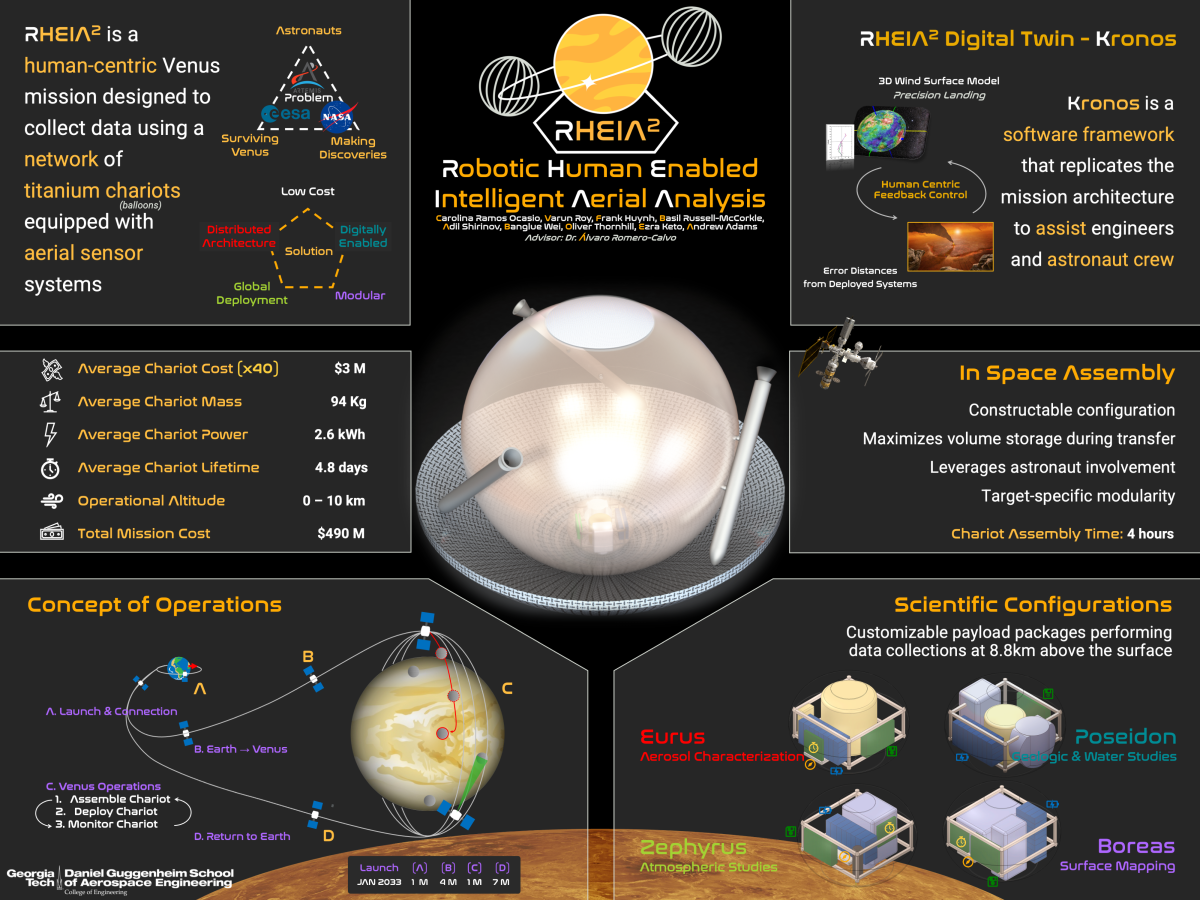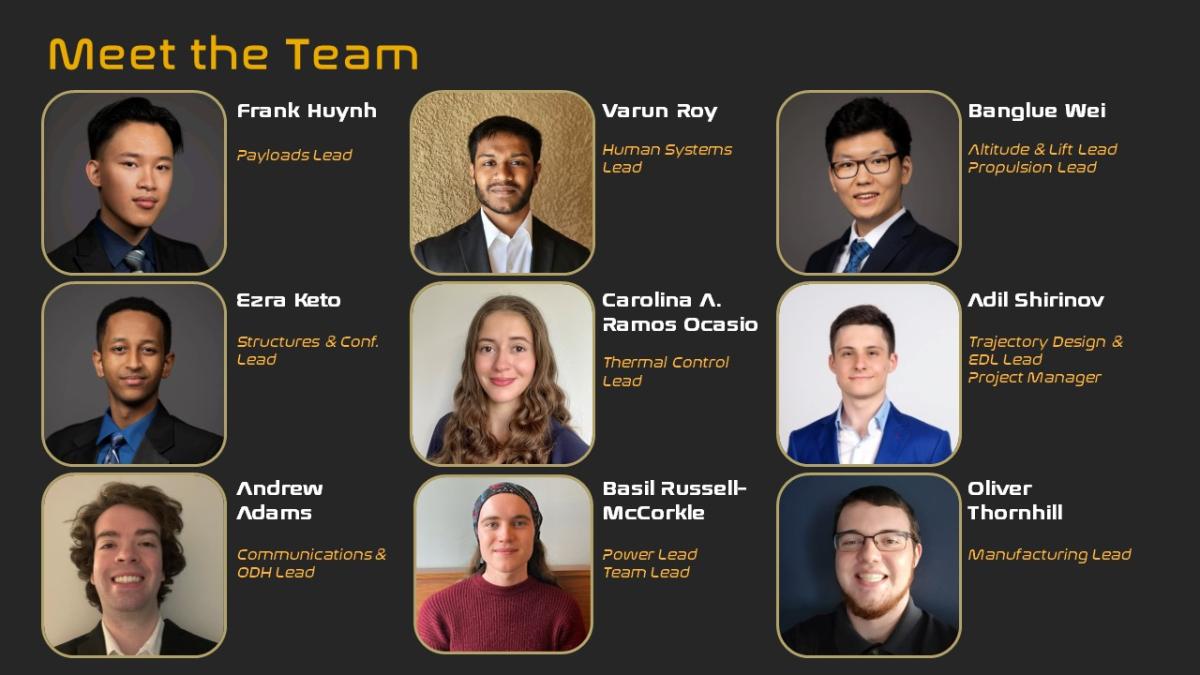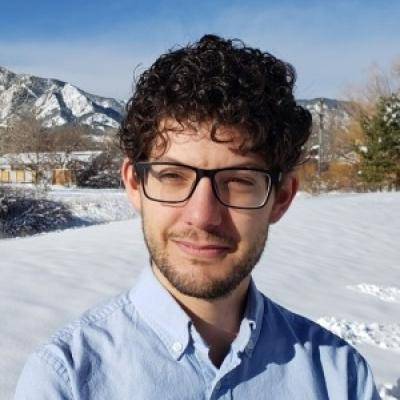Aerospace students showcase senior projects to explore, excavate, rescue, and investigate our world and beyond.
RHEIA Team from the top left to right: Ezra Keto, Basil Russell-McCorkle, Varun Roy, Carolina A. Ramos Ocasio, Adil Shirinov and Frank Huynh. From the bottom left to right: Banglue Wei and Oliver Thornhill.
RHEIA2, a nine-member team on a mission to investigate Venus, landed the Aerospace Engineering Best Fall 2023 Capstone Design title and a $1,000 award at McCamish Pavilion. Frank Huynh, Ezra Keto, Carolina Ramos Ocasio, Varun Roy, Basil Russell-McCorkle, Adil Shirinov, Oliver Thornhill, Banglue Wei, and Andrew Adams make up the winning team who competed with 15 other dynamic and innovative aerospace engineering teams for the coveted title. Overall, there were 129 teams across six schools and two colleges.
"They not only came up with a brilliant concept but were also able to explain it to a broad audience by preparing a genuinely inspiring display. RHEIA2’s success again demonstrates the impressive capabilities of our space systems design students. Congratulations to them and the other AE teams who participated in the Expo,” said Assistant Professor Romero-Calvo.
Out of the Ordinary Comes the Extraordinary
What do you do with Venus, the most inhospitable planet in our solar system? You study it. Team RHEIA2, formerly known as GenetriX, aims to collect and analyze planetary data using modular robotic balloons and humans. The titanium balloons, also known as chariots, will allow a wide area of analysis around the planet.
“The balloons will hold one of four types of payload packages to carry out either surface mapping, atmospheric studies, geologic and water studies, or aerosol characterization,” Roy elaborated. “They will be deployed from various areas above Venus.”
The mission will start on Earth with four astronauts onboard a SpaceX Falcon 9 that will launch to NASA’s deep space gateway (DSG). The mobile space station is the first rendezvous stop in low earth orbit at an altitude of 1200 miles, allowing the astronauts to go into deep space. After leaving, the astronauts will begin a four-month journey to Venus.
Once in Venus’ orbit, they will spend 30 days assembling the 40 balloons and launching them in increments of 1- 2 per day to the planet's surface. Each balloon will cost roughly $3.2 million for a mission cost of $490 million, well under the budget cap.
While in orbit, the astronauts will use a custom digital twin framework to ensure mission success. Shirinov, the trajectory and entry, descent, and landing (EDL) Lead, wrote the digital twin code to equip the astronauts with a reliable tool to successfully deploy the balloons at the regions of most scientific value.
“The digital twin – Kronos, incorporates the critical subsystems of the mission, including thermals, EDL, communications, and more. This digital twin requires representative data of Venus's atmospheric and wind conditions. However, we don't have an accurate dataset on hand; instead, we use probabilistic models that humans will refine in real-time. This strategy increases our mission success likelihood by 400%,” Shirinov explained.

RHEIA 2 Poster
Overcoming Challenges as a Team
One of RHEIA2’s most significant challenges was ensuring the interfaces between the subsystems were adequate and worked congruently. Each team member had a lead role, and they had to work together and talk to each other frequently for the mission to be successful. The team spent long hours and days working together.

RHEIA Team
Russell-McCorkle, the power lead, had to figure out how to generate power for the payloads in the atmosphere of Venus. While designing the battery for the payload, she came across many batteries that would not operate at extreme temperatures. She reached out to NASA Engineer John Paul Jones who helped her find a battery that would work for the project. Ultimately, she chose an iron sulfide cathode battery.
The balloon concept required Wei, the propulsion and altitude control lead, to find a way to make the balloons stay in the air.
“Each item has mass and volume, and any empty space left over will be filled with lifting gas, which also has mass. More volume in a balloon means more lifting, but also fewer total balloons we could carry. At one point, our design was overweight. We had to come up with several solutions, such as equalizing pressure with the outside to allow the shell to be thinner and lighter,” Wei said.
Through trial and error, they switched the gas from water vapor and nitrogen to helium because they could assemble it in space. This caused the balloon to become lighter, enabling the allocation of mass to other subsystems, and increasing their operational altitude to a location of more favorable environmental conditions.
Ramos Ocasio’s subsystem, thermal control, was one of the last ones to be completed because she needed everyone else’s required size and temperature information to model the thermal dynamics for the balloon.
“We were able to design the thermal control to be modular, low-cost, and passive, a key aspect of our balloon and our entire robotic mission. Previous missions to Venus averaged a lifetime of a few hours. We’ve designed our thermal control to last about five days,” Ramos Ocasio said.
Despite the challenges, their hard work, dedication, and ongoing communication led them to victory. RHEIA2 plans to compete in other challenges, including the American Institute of Aeronautics and Astronautics student design competitions.
